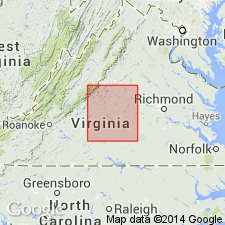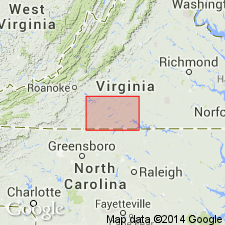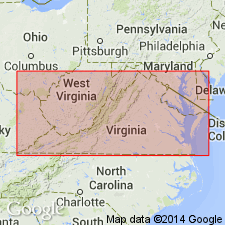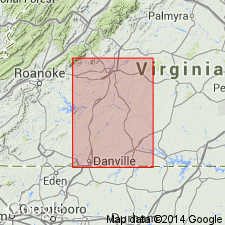
- Usage in publication:
-
- Melrose granite facies
- Modifications:
-
- Named
- Dominant lithology:
-
- Granite
- AAPG geologic province:
-
- Piedmont-Blue Ridge province
Jonas, A.I., 1932, Kyanite in Virginia: Virginia Geological Survey Bulletin, no. 38, 52 p.
Summary:
Named the Melrose granite facies of the Columbia granite for Melrose, Campbell Co., central VA. Facies is much coarser grained and darker colored than Columbia granite. In area east of McKeever Ferry the Melrose has been converted into augen gneiss. Intrudes Wissahickon formation. The Melrose is of Precambrian age.
Source: GNU records (USGS DDS-6; Reston GNULEX).

- Usage in publication:
-
- Melrose granite
- Modifications:
-
- Revised
- AAPG geologic province:
-
- Piedmont-Blue Ridge province
Summary:
Revised to Melrose granite. Unit is of Precambrian or Paleozoic age.
Source: GNU records (USGS DDS-6; Reston GNULEX).

- Usage in publication:
-
- Melrose Granite
- Modifications:
-
- Age modified
- Geochronologic dating
- AAPG geologic province:
-
- Piedmont-Blue Ridge province
Summary:
U-Pb zircon dating of the Melrose Granite indicates it is of Cambrian age (515 Ma).
Source: GNU records (USGS DDS-6; Reston GNULEX).

- Usage in publication:
-
- Melrose Granite
- Modifications:
-
- Overview
- AAPG geologic province:
-
- Piedmont-Blue Ridge province
Summary:
The Melrose granite consists of light-greenish-gray to pink-banded, massive, medium- to coarse-grained biotite granite; ranges in composition from quartz monzonite to quartz diorite. Where unit is cut by the Brookneal shear zone, it progresses southeasterly from protomylonite to mylonite to ultramylonite. Contains quartz, plagioclase, potassium feldspar, biotite, muscovite, chlorite, epidote, titanite, garnet, magnetite-ilmenite, calcite, and zircon. The Melrose is of Cambrian age.
Source: GNU records (USGS DDS-6; Reston GNULEX).

- Usage in publication:
-
- Melrose Granite*
- Modifications:
-
- Areal extent
- AAPG geologic province:
-
- Piedmont-Blue Ridge province
Summary:
Undeformed Melrose Granite near the Brookneal shear zone, central VA consists of coarse, randomly to slightly oriented grains. Near the shear zone it develops a pervasive foliation with corresponding grain size reduction from recrystallization.
Source: GNU records (USGS DDS-6; Reston GNULEX).
For more information, please contact Nancy Stamm, Geologic Names Committee Secretary.
Asterisk (*) indicates published by U.S. Geological Survey authors.
"No current usage" (†) implies that a name has been abandoned or has fallen into disuse. Former usage and, if known, replacement name given in parentheses ( ).
Slash (/) indicates name conflicts with nomenclatural guidelines (CSN, 1933; ACSN, 1961, 1970; NACSN, 1983, 2005, 2021). May be explained within brackets ([ ]).

